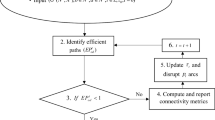Abstract
The paper is devoted to a new family of variational problems for differential inclusions, motivated by the protection of human and wildlife habitats when an invasive environmental disaster occurs. Indeed, the mathematical model consists of a differential inclusion describing the expansion of invaded region over time, and an artificial barrier that cannot be penetrated by the invasive agent is erected to shield the habitat, which serves as the control strategy and is characterized as a one-dimensional rectifiable set. We consider an isotropic case that the disaster spreads with uniform speed in all directions, and develop an equivalence result on the minimum construction speed required for implementing a sheltering strategy determined by a rectifiable Jordan curve. By measuring the invaded portion of barriers over time, it is shown that each connected non-convex habitat admits an equivalent habitat that contains the given habitat and their minimum speeds are equal. In particular, the boundary of an equivalent habitat can be partitioned into two arcs: an arc is locally convex, and the other is part of the boundary of illuminated area. This leads to a corollary on the existence of admissible sheltering strategies for non-convex habitats.
Similar content being viewed by others
References
Ambrosio, L., Colesanti, A., Villa, E.: Outer Minkowski content for some classes of closed sets. Math. Annal. 342, 727–748 (2008)
Aubin, J.P., Cellina, A.: Differential Inclusions. Springer, Berlin (1984)
Bressan, A.: Differential inclusions and control of forest fires. J. Differential Equations 243, 179–207 (2007)
Bressan, A.: Dynamic blocking problems for a model of fire propagation. Adv. Appl. Math Model. Comput. Sci., Fields Inst. Commun. 66, 11–40 (2013)
Bressan, A., Burago, M., Friend, A., Jou, J.: Blocking strategies for a fire control problem. Anal. Appl. 6, 229–246 (2008)
Bressan, A., De Lellis, C.: Existence of optimal strategies for a fire confinement problem. Comm. Pure Appl. Math. 62, 789–830 (2009)
Bressan, A., Piccoli, B.: Introduction to the Mathematical Theory of Control, Springfield Mo (2007)
Bressan, A., Wang, T.: Equivalent formulation and numerical analysis of a fire confinement problem. ESAIM: Control Optim. Calc. Var. 16, 974–1001 (2010)
Bressan, A., Wang, T.: Global optimality conditions for a dynamic blocking problem. ESAIM: Control Optim. Calc. Var. 18, 124–156 (2012)
Bressan, A., Wang, T.: On the optimal strategy for an isotropic blocking problem. Calc. Var. and PDEs 45, 125–145 (2012)
Bressan, A., Wang, T.: The minimum speed for a blocking problem on the half plane. J. Math. Anal. Appl. 356, 133–144 (2009)
Conway, J.B.: Functions of One Complex Variable, vol. II. Springer, New York (1995)
De Lellis, C., Robyr, R.: Hamilton-jacobi equations with obstacles. Arch. Rational Mech. Anal. 200, 1051–1073 (2011)
Falconer, K.J.: The Geometry of Fractal Sets. Cambridge University Press (1986)
Freitag, E., Busam, R.: Complex Analysis, 2nd Edn. Springer, Berlin (2009)
Leoni, G.: A First Course in Sobolev Spaces. American Mathematical Society (2009)
Wang, T.: Optimality conditions for a blocking strategy involving delaying arcs. J. Optim. Theory Appl. 152, 307–333 (2012)
Wang, T.: Dynamic sheltering problem and an existence theorem for admissible strategies. Set-Valued Var. Anal. 22, 391–446 (2014)
Author information
Authors and Affiliations
Corresponding author
Rights and permissions
About this article
Cite this article
Wang, T. An Equivalence Theorem on Minimum Sheltering Speed for Non-convex Habitats. Set-Valued Var. Anal 26, 531–560 (2018). https://doi.org/10.1007/s11228-016-0396-1
Received:
Accepted:
Published:
Issue Date:
DOI: https://doi.org/10.1007/s11228-016-0396-1




